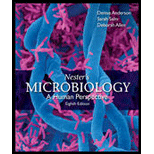
Concept explainers
How is preservation different from pasteurization?
To review:
The difference between the preservation and the pasteurization.
Introduction:
Microorganisms are found in every possible place and environmental conditionals like air, water, hot springs, deep thermal vents, and in saline conditions. They are microscopic and can grow rapidly. However, it becomes crucial in some cases, such as in food, medicines, and in open wounds where these microbes need to get rid off in order to eliminate the chances of infections and diseases. Thus, several methods of sterilization and preventive are available so as to destroy or prevent their spread.
Explanation of Solution
Various measures including physical, chemical, or a combination of both are employed to control or prevent the microbial growth at the unwanted places. The physical methods comprise washing, irradiation, filtration, and heat treatment, whereas the chemical methods include the use of various chemicals, disinfectants, and other drugs to kill the microbes and thus, prevent their growth. The main processes followed to control the microbial growth are:sterilization, disinfection, preservation, and pasteurization.
The main difference between the preservation and the pasteurization is tabulated as follows:
| Preservation | Pasteurization |
| (1) It refers to the process of delaying the spoilage of the products which can get decay fast (perishable items) such as vegetables. | (1) This refers to the heat treatment for a short period of time without changing the properties of the materials as it increases the shelf-life of the product. |
| (2) This can be done by storing the materials at cold temperatures or by adding preservatives. | (2) The most used pasteurization is high-temperature short-time (HTST) for milk. Other than this, ultra-high-temperature (UHT) pasteurization is also used for juices and wine. |
| (3) They have the bacteriostatic effect, that is, they inhibit the microbial growth without killing them. | (3) In this method, most of the microbes responsible for spoilage are killed and are reduced in number too. |
Therefore, the methods of preservation and pasteurization are used to control the spoilage of food material due to the growth of microbes. Preservation includes inhibition of their growth without killing them, whereas pasteurization is the killing of the microbes by a heat treatment for a short time.
Want to see more full solutions like this?
Chapter 5 Solutions
Nester's Microbiology: A Human Perspective
- What is the purpose of pasteurization in performing a simple fermentation process utilizing available raw materials such as fresh fruit and vegetables?arrow_forwardWhat are several microbial targets of pasteurization?arrow_forwardWhat microorganisms serve as the reference point in determining the time and temperature of pasteurization?arrow_forward
- Describe the difference between blanching, pasteurization, and canning. What is the purpose of each preservation method, how is the treatment carried out and how are the products to be stored after the treatment?arrow_forwardWhy can milk become sour due to bacteria even though it has been pasteurized?arrow_forwardWhat is the difference between cleaning, sanitizing, and disinfecting?arrow_forward
 Human Anatomy & Physiology (11th Edition)BiologyISBN:9780134580999Author:Elaine N. Marieb, Katja N. HoehnPublisher:PEARSON
Human Anatomy & Physiology (11th Edition)BiologyISBN:9780134580999Author:Elaine N. Marieb, Katja N. HoehnPublisher:PEARSON Biology 2eBiologyISBN:9781947172517Author:Matthew Douglas, Jung Choi, Mary Ann ClarkPublisher:OpenStax
Biology 2eBiologyISBN:9781947172517Author:Matthew Douglas, Jung Choi, Mary Ann ClarkPublisher:OpenStax Anatomy & PhysiologyBiologyISBN:9781259398629Author:McKinley, Michael P., O'loughlin, Valerie Dean, Bidle, Theresa StouterPublisher:Mcgraw Hill Education,
Anatomy & PhysiologyBiologyISBN:9781259398629Author:McKinley, Michael P., O'loughlin, Valerie Dean, Bidle, Theresa StouterPublisher:Mcgraw Hill Education, Molecular Biology of the Cell (Sixth Edition)BiologyISBN:9780815344322Author:Bruce Alberts, Alexander D. Johnson, Julian Lewis, David Morgan, Martin Raff, Keith Roberts, Peter WalterPublisher:W. W. Norton & Company
Molecular Biology of the Cell (Sixth Edition)BiologyISBN:9780815344322Author:Bruce Alberts, Alexander D. Johnson, Julian Lewis, David Morgan, Martin Raff, Keith Roberts, Peter WalterPublisher:W. W. Norton & Company Laboratory Manual For Human Anatomy & PhysiologyBiologyISBN:9781260159363Author:Martin, Terry R., Prentice-craver, CynthiaPublisher:McGraw-Hill Publishing Co.
Laboratory Manual For Human Anatomy & PhysiologyBiologyISBN:9781260159363Author:Martin, Terry R., Prentice-craver, CynthiaPublisher:McGraw-Hill Publishing Co. Inquiry Into Life (16th Edition)BiologyISBN:9781260231700Author:Sylvia S. Mader, Michael WindelspechtPublisher:McGraw Hill Education
Inquiry Into Life (16th Edition)BiologyISBN:9781260231700Author:Sylvia S. Mader, Michael WindelspechtPublisher:McGraw Hill Education





